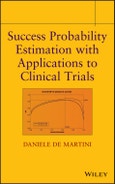Success Probability Estimation with Applications to Clinical Trials details the use of success probability estimation in both the planning and analyzing of clinical trials and in widely used statistical tests.
Devoted to both statisticians and non-statisticians who are involved in clinical trials, Part I of the book presents new concepts related to success probability estimation and their usefulness in clinical trials, and each section begins with a non-technical explanation of the presented concepts. Part II delves deeper into the techniques for success probability estimation and features applications to both reproducibility probability estimation and conservative sample size estimation.
Success Probability Estimation with Applications to Clinical Trials:
- Addresses the theoretical and practical aspects of the topic and introduces new and promising techniques in the statistical and pharmaceutical industries
- Features practical solutions for problems that are often encountered in clinical trials
- Includes success probability estimation for widely used statistical tests, such as parametric and nonparametric models
- Focuses on experimental planning, specifically the sample size of clinical trials using phase II results and data for planning phase III trials
- Introduces statistical concepts related to success probability estimation and their usefulness in clinical trials
Success Probability Estimation with Applications to Clinical Trials is an ideal reference for statisticians and biostatisticians in the pharmaceutical industry as well as researchers and practitioners in medical centers who are actively involved in health policy, clinical research, and the design and evaluation of clinical trials.
Table of Contents
Preface xv
Acknowledgments xvii
Acronyms xix
Introduction xxi
I.1 Overview of clinical trials xxii
I.2 Success rates of clinical trials xxiv
I.3 Success probability xxv
I.4 Starting from practice xxvii
PART I SUCCESS PROBABILITY ESTIMATION IN PLANNING AND ANALYZING CLINICAL TRIALS
1 Basic statistical tools 3
1.1 Pointwise estimation 4
1.2 Confidence interval estimation, conservative estimation 6
1.3 The statistical hypotheses, the statistical test and the type I error for one-tailed tests 10
1.4 The power function and the type II error 11
1.5 The p-value 14
1.6 The success probability and its estimation 17
1.7 Basic statistical tools for two tailed tests 19
1.8 Other statistical hypotheses and tests 23
2 Reproducibility Probability Estimation 25
2.1 Pointwise RP estimation 26
2.2 RP-testing 29
2.3 The RP estimate and the p-value 32
2.4 Statistical lower bounds for the RP 35
2.5 The stability criterion for statistical significance 37
2.6 Other stability criteria for statistical significance 40
2.7 Comparing stability criteria 43
2.8 Regulatory agencies and the single study 45
2.9 The RP for two-tailed tests 46
2.10 Discussing Situation I in Section I.4.1 49
3 Sample Size Estimation 51
3.1 The classical paradigm of sample size determination 52
3.2 SP estimation for adapting the sample size 55
3.3 Launching the trial in practice 57
3.4 Practical aspects of SSE 60
3.5 Frequentist conservative SSE 67
3.6 Optimal frequentist CSSE 70
3.7 Bayesian CSSE 75
3.8 A comparison of CSSE strategies 80
3.9 Discussing Situations I and II in Section I.4 83
3.10 Sample size estimation for the two-tailed setting 85
4 Robustness and Corrections in Sample Size Estimation 89
4.1 CSSE strategies with different effect sizes in phases II and III 90
4.2 Comparing CSSE strategies in different Scenarios 91
4.3 Corrections for CSSE strategies 94
4.4 A comparison among Corrected CSSE strategies 97
PART II SUCCESS PROBABILITY ESTIMATION FOR SOME WIDELY USED STATISTICAL TESTS
5 General parametric SP estimation 105
5.1 The parametric model 105
5.2 Power, SP and noncentrality parameter estimation 106
5.3 RP estimation and testing 107
5.4 Sample size estimation 108
5.5 Statistical tests included in the model 109
6 SP estimation for Student’s t statistical tests 113
6.1 Test for two means equal variances 114
6.1.1 Power and RP estimation 114
6.2 Test for two means unequal variances 117
6.3 On Student’s t RP estimates 120
7 SP estimation for Gaussian distributed test statistics 123
7.1 Test for two proportions 123
7.2 Test for survival: the log-rank test 127
8 SP estimation for Chi-square statistical tests 133
8.1 Test for two multinomial distributions: 2 x C comparative trial 133
8.2 Test for S couples of binomial distributions: the Mantel-Haenszel test 137
8.3 On χ2 RP estimates 141
9 General nonparametric SP estimation with - applications to the Wilcoxon test 143
9.1 The nonparametric model 144
9.2 General nonparametric SP estimation 145
9.3 The Wilcoxon rank-sum test 146
A Tables of quantiles 161
B Tables of RP estimates for the one-tailed Z test 169
References 179
Topic index 185
Author index 193








